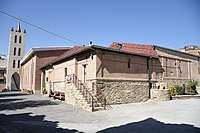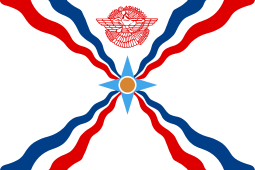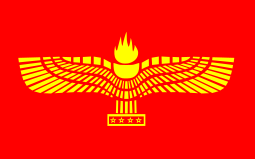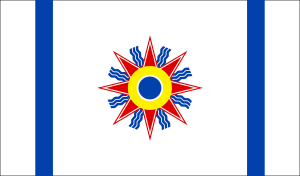Assyrians in Iran
Assyrians in Iran, Iranian Assyrians or Persian Assyrians (Syriac: ܐܬܘܪܝܐ ܕܐܝܼܪܵܢ), (Persian: آشوریان ایران), are an ethnic and linguistic minority in present-day Iran. The Assyrians of Iran speak Assyrian Neo-Aramaic, a neo-Aramaic language descended from Classical Syriac and elements of Akkadian, and are Eastern Rite Christians belonging mostly to the Assyrian Church of the East and also to the Ancient Church of the East, Assyrian Pentecostal Church, Chaldean Catholic Church and Assyrian Evangelical Church.[2]
Assyrians from Sena, Kurdistan Province of Persia | |
| Total population | |
|---|---|
| 7,000-17,000[1] | |
| Regions with significant populations | |
| Languages | |
| Neo-Aramaic and Persian | |
| Religion | |
| Syriac Christianity |
They share a common history and ethnic identity, rooted in shared linguistic, cultural and religious traditions, with Assyrians in Iraq, Assyrians in Turkey and Assyrians in Syria, as well as with the Assyrian diaspora.[2]
The Assyrian community in Iran numbered approximately 200,000 prior to the Islamic Revolution of 1979. In 1987, there were an estimated 50,000 Assyrians living in Tehran.[3] However, after the revolution many Assyrians left the country, primarily for the United States; the 1996 Iranian census counted only 32,000 Assyrians.[4] Current estimates of the Assyrian population in Iran consist of 7,000 combined members of the Assyrian Church of the East and Chaldean Catholic Church in addition to less than 10,000 members of the Assyrian Evangelical Church.[5]
The Iranian capital, Tehran, is home to the majority of Iranian Assyrians; however, approximately 15,000 Assyrians reside in northern Iran, in Urmia and various Assyrian villages in the surrounding area.[2]
The Constitution of the Islamic Republic of Iran, ratified in 1979, recognizes Assyrians as a religious minority and ethnic minority and reserves for them one seat in the Islamic Consultative Assembly, the Iranian parliament.[6] As of 2004, the seat was occupied by Yonathan Betkolia, who was elected in 2000 and reelected in the 2004 legislative election.
In 2010, it was estimated that there were only around 5,000 Assyrians left in the historical center of the city of Urmia.[7]
History
_Christian_family_making_butter%2C_Mawana%2C_Persia.jpg)
The Assyrian presence in Iran goes back 4,000 years to ancient times, and Assyria was involved in the history of Ancient Iran even before the arrival of the modern Iranian peoples to the region circa 1000 BC. During the Old Assyrian Empire (c.2025-1750 BC) and Middle Assyrian Empire (1365-1020 BC) the Assyrians ruled over parts of Pre-Iranic northern and western Iran. The Neo-Assyrian Empire (911-605 BC) saw Assyria conquer the Iranic Persians, Medes and Parthians into their empire, together with the ancient pre-Iranic Elamites, Kassites, Manneans and Gutians, and also the Iranic Cimmerians of Asia Minor and Scythians of the Caucasus.[8] The home of the Assyrians in Iran has traditionally been along the western shore of Lake Urmia from the Salmas area to the Urmia plain.[9]
After the fall of Assyria between 612 and 599 BC, after decades of civil war, followed by an attack by an alliance of former subject peoples; the Medes, Persians, Babylonians, Chaldeans, Scythians and Cimmerians, its people became an integral part of the Achaemenid Empire (as did Assyria itself), holding important military, civic and economic positions, and the Achaemenid Persians, having spent centuries under Assyrian domination, were greatly influenced by Assyrian Art and Architecture, modelled their empire upon Assyrian lines, and saw themselves as the successors of the great Assyrian kings. Assyrians are still attested as being extant in the north west of the region during the Parthian Empire (160 BC-223 AD) and Sassanid Empire (224-650 AD), and throughout the Middle Ages, where the Bukhtishu family of physicians were held in great regard by the Persian kings.
There were about 200,000 Assyrians in Iran at the time of the 1976 census.[9] Many emigrated after the revolution in 1979, but at least 50,000 were estimated to be still in Iran in 1987.
In 1900, Assyrians numbered over 76,000 in northwestern Iran, constituting over a quarter of the Azerbaijan province's population and were the largest non-Muslim majority in Urmia. Of the 300 villages around Urmia, 60 were exclusively Assyrians and 60 were mixed villages with Assyrian, Armenian, and Azeri communities. Nevertheless, there were over 115 documented Assyrian villages to the west of Lake Urmia prior to 1918.[8]
During the Assyrian Genocide, which took place in World War I, the Ottoman Army together with allied Kurdish, Azeri and Arab militias along the Iranian-Turkish and Iranian-Iraqi border carried out religiously and ethnically motivated massacres and deportations on unarmed Assyrian civilians (and Armenians) both in the mountains and on the rich plains, resulting in the death of at least 300,000 Assyrians.[10] In 1914 alone, they attacked dozens of villages and drove off all the inhabitants of the district of Gawar. The Assyrians defended themselves and for a time successfully repelled further attacks under the leadership of Agha Petros, seizing control of much of the Urmia region and defeating Ottoman forces and their Kurdish, Arab and Azeri allies in the process. However lack of ammunition and supplies, due mainly to the withdrawal of Russia from the war, and the collapse of allied Armenian forces led to their downfall. Massively outnumbered, surrounded, undersupplied and cut off, the Assyrians suffered terrible massacres.
By the summer of 1918 almost all surviving Assyrians had fled to Tehran or to existing Assyrian communities or refugee camps in Iraq such as Baqubah. Local Kurds, Arabs and Azeris took the opportunity of the last phases of World War I to rob Assyrian homes, murder civilians and leave those remaining destitute. The critical murder that sowed panic in the Assyrian community came when Kurdish militias, under Agha Ismail Simko, assassinated the Patriarch, Mar Benyamin Shimon XIX, on March 3, 1918, under the pretext of inviting him to negotiations, although the Assyrian leader Malik Khoshaba exacted revenge upon Simko by attacking and sacking his citadel, forcing the Kurdish leader to flee for his life.[9]
Religious communities
Most Assyrians in Iran are followers of the Assyrian Church of the East, with a minority of 3,900 following the Chaldean Catholic Church.[11] Some also follow Protestant denominations such as the Assyrian Evangelical Church, Assyrian Pentecostal Church and possibly Russian Orthodoxy due to a Russian Ecclesiastical Mission in Urmia during the 1900s.
Churches

- Holy Mary (Mart Maryam) Church - Urmia - 1st century
- Assyrian Pentecostal Church, Kermanshah - Kermanshah - 1955
- St. Cyriacus (Mar Kuryakus) Church - Urmia - 18th century
- Holy Mary (Mart Maryam) Church - Urmia - CharBakhsh - 5th century
- Holy Gabriel (Mar Gabriel) Church - Urmia - Ordushahi - 19th century
- St. Shalita (Mar Shalita) Church - Urmia - Shirabad - 19th century
- St. Joseph (Mar Yozep) Church - Urmia - Shirabad - 1897
- St. Sarkis (Mar Sargiz) Church - 5 km SW of Urmia - Seir - 5th century
- Holy Zion (Mar Sehyon) Church - 8 km E of Urmia - Golpashan
- St. George (Mar Gevargiz) Church - 8 km E of Urmia - Golpashan - 1905
- Holy Mary (Mart Maryam) Church - 8 km E of Urmia - Golpashan
- Sts. Peter-Paul (Mar Petros-Paulos) Church - 10 km E of Urmia - 8th century - believed to be built by Bukhtishu
- Holy Mary (Mart Maryam) Church - 32 km E of Urmia - Mavana
- St. Daniel (Mar Danial) Church - 25 km N of Urmia - Nazlu River - 5th century - destroyed in World War I, rebuilt
- St. John (Mar Yokhanah) Church - 45 km N of Urmia - Jamalabad - 5th century
- St. John (Mar Yokhanah) Church - 24 km N of Urmia - Adeh - 1901
- St. Sabrisho (Mar Sabrisho) Church - 30 km N of Urmia - Mushiabad - 1880
- St. George (Mar Gevargiz) Church - 35 km N of Urmia - Sopurghan - 1830
- St. John (Mar Yokhanah) Church - 40 km N of Urmia - Gavilan - 5th century
- St. John (Mar Yokhanah) Church - 40 km N of Urmia - Gavilan - 19th century
- St. Thomas (Mar Toma) Church - 30 km W of Urmia - Balulan - 7th century
- St. Cyriacus (Mar Kuryakus) Church - Salmas - Kohneshahr - 12th century
- St. James (Mar Yakob) Church - Salmas - Kohneshahr - 19th century
- St. Khinah (Mar Khinah) Church - Salmas - Sarna
- Holy Mary (Mart Maryam) Church - Salmas - Savera
- Vank - 2 km S of Salmas - Khosrowabad - 5th century - The Holy Cross of Jerusalem was kept here for a while.
- St. Sarkis (Mar Sargiz) Church - 2 km S of Salmas - Khosrowabad - 1869
- St. George (Mar Gevargiz) Church - 2 km S of Salmas - Khosrowabad - 1845
- Church - 12 km SW of Salmas - Akhtekhaneh - 1890
- St. Sarkis (Mar Sargiz) Church - 2 km S of Salmas - Khosrowabad - 1869
- Holy Mary (Mart Maryam) Church - Sehna
- St. George (Mar Gevargiz) Church - Tehran (Bagh-e-Shah) - 1962
- Holy Mary (Mart Maryam) Church - Tehran (Sarbaz St.) - 1978
- St. Joseph (Mar Yozep) Church - Tehran (Forsat St.) - 1950
- Holy Virgin Church - Tehran (Appadana St.)
- Chaldean Catholic Chapel - Eslamshahr Catholic Cemetery - 1967
- St. Thomas (Mar Toma) Church - Tehran (Amirabad) - 1967
- Assyrian Brotherhood Church - Tehran (ShahrAra St.)
Famous Assyrians from Iran
- Hannibal Alkhas, poet and visual artist
- Andre Agassi, Assyrian-Armenian tennis player
- Evin Agassi, music artist
- Mike Agassi, Olympic boxer and father of Andre Agassi
- Ramona Amiri, Miss World Canada 2005
- Ashurbanipal Babilla, actor, theatre director, playwright and visual artist
- Steven Beitashour, MLS player
- Bukhtishu family, famous physicians in the Middle Ages
- Beneil Dariush, MMA fighter
- Eprime Eshag, Fellow of Wadham College, Oxford
- Alexander L. George, Graham H. Stuart Professor of Political Science Emeritus at Stanford University
- Mar Youhannan Semaan Issayi, Archbishop of Assyro-Chaldean Metropolitan Tehran
- George Malek-Yonan, procured a seat in the Iranian Parliament for Assyrians
- Rosie Malek-Yonan, actress, author and activist
- Andrew David Urshan, evangelist and author
See also
- Christians in Iran
- Ethnic minorities in Iran
- List of Assyrian settlements
- Religious minorities in Iran
- Russian Ecclesiastical Mission in Urmia
- Urmia Orthodokseta
Notes
- . U.S. Department of State 2018 Report on International Religious Freedom: Iran https://www.state.gov/reports/2018-report-on-international-religious-freedom/iran/. Missing or empty
|title=(help) - Hooglund (2008), pp. 100–101.
- "ASSYRIANS IN IRAN i. The Assyrian community ( – Encyclopaedia Iranica". www.iranicaonline.org. Retrieved 2020-05-20.
- Hooglund (2008), pp. 100–101, 295.
- "Iran". United States Department of State. Retrieved 2020-05-20.
- Hooglund (2008), pp. 128–129.
- Nicholas al-Jeloo, Evidence in Stone and Wood: The Assyrian/Syriac History and Heritage of the Urmia Region in Iran. Parole de l'Orient 35 (2010), pp. 1-15.
- http://www.jaas.org/edocs/v20n1/Arianne-diaspora.pdf
- Iran A Country Study By Federal Research Division - Page 128
- David Gaunt, "The Assyrian Genocide of 1915", Assyrian Genocide Research Center, 2009
- As of 2014, when combining the populations of all the Iranian diocese together, there are 3,900 followers http://www.catholic-hierarchy.org/rite/dch2.html
References
- Hooglund, Eric (2008). "The Society and Its Environment". In Curtis, Glenn E.; Hooglund, Eric (eds.). Iran: A Country Study (PDF). Area Handbook Series. United States Library of Congress, Federal Research Division (5th ed.). Washington, D.C.: United States Government Printing Office. pp. 81–142. ISBN 978-0-8444-1187-3. Retrieved 13 October 2013.
Bibliography
- Eden Naby, “The Assyrians of Iran: Reunification of a ‘Millat,’ 1906-1914" International Journal of Middle East Studies, 8. (1977) pp. 237–249
- Eden Naby, “The Iranian Frontier Nationalities: The Kurds, the Assyrians, the Baluch and the Turkmens,”Soviet Asian Ethnic Frontiers, ed.by McCagg and Silver (New York, Pergamon Press, 1979).
- Eden Naby, “Christian Assyrian Architecture of Iran,” News – Harvard University Center for the Study of World Religions (Spring 1998) vol. 5, no. 2, p. 7, 10.
- Eden Naby, "Ishtar: Documenting the Crisis in the Assyrian Iranian Community," MERIA 10/4 (2006)https://web.archive.org/web/20090124055153/http://meria.idc.ac.il/journal/2006/issue4/Naby.pdf


